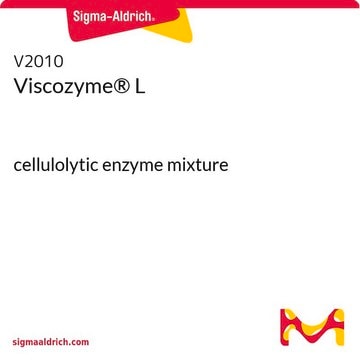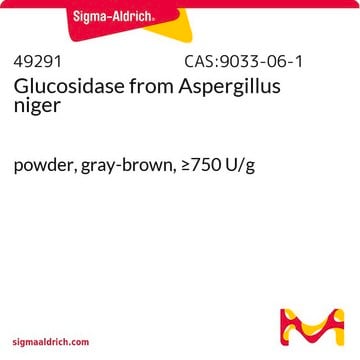This Cellulase blend is a product of Novozymes. The analytical testing confirms that this material meets the 1000 unit/gram minimum activity, as well as the lot specific density. The density range is 1.0 - 1.3 g/mL. As an example, a 50 mL package size for a lot reporting a density of 1.2 g/mL with an activity of 1000 units per gram would have a minimum concentration of 1200 u/mL. Please see the link below to access a sample or lot specific Certificate of Analysis:
https://www.sigmaaldrich.com/product/sigma/sae0020#product-documentation
SAE0020
Cellulase, enzyme blend
Synonym(s):
Cellic CTec2
About This Item
Recommended Products
General description
Application
Biochem/physiol Actions
Legal Information
Signal Word
Danger
Hazard Statements
Precautionary Statements
Hazard Classifications
Resp. Sens. 1
Storage Class Code
10 - Combustible liquids
WGK
WGK 3
Choose from one of the most recent versions:
Certificates of Analysis (COA)
Don't see the Right Version?
If you require a particular version, you can look up a specific certificate by the Lot or Batch number.
Already Own This Product?
Find documentation for the products that you have recently purchased in the Document Library.
Customers Also Viewed
-
what is the concentration (units/ml) of the enzyme?
1 answer-
Helpful?
-
-
1. How much glucose and xylose sugars are present in Cellic CTec2? 2. And how many other ingredients are included? 3. From what microorganisms do the Cellulase, β-glucosidase, and Hemicellulase enzymes originate?
1 answer-
The composition of this material is considered proprietary. This product is manufactured by fermentation of microorganisms not present in the final product. Please see the link below to a publication that may be helpful.
https://dspace.lib.cranfield.ac.uk/bitstream/handle/1826/15255/Augmented_hydrolysis_of_acid_pretreated_sugarcane_bagasse-2020.pdf;jsessionid=75390AF54DD520E2E7334DC8525A57C3?sequence=4Helpful?
-
-
What is this cellulase enzyme activity? ?FPU
1 answer-
This is a product of Novoxymes. The manufacturer notes that this cellulase will hydrolyze (1,4)-beta-D-glucoside linkages and reports the activity in Biomass hydrolysis Units or BHU-2 per gram. This activity is a minimum of 1000 BHU-2 units per gram.
Helpful?
-
-
OPTIMIZATION VALUES OF PH, T°, AND UNITS TO WORK WITH THIS ENZYME
1 answer-
The optimum temperature is 45-50°C and the optimum pH is 5.0–5.5.
Helpful?
-
-
is it possible to know the MW for the enzymes
1 answer-
This product is a proprietary blend of cellulases, ß-glucosidases, and hemicellulase. The molecular weight for this item is not determined.
Helpful?
-
Active Filters
Our team of scientists has experience in all areas of research including Life Science, Material Science, Chemical Synthesis, Chromatography, Analytical and many others.
Contact Technical Service










